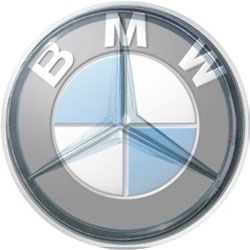The community of interest between BMW and the Mercedes-Benz component of Daimler has been the subject of much analysis and speculation, with some suggesting that the two companies eventually will have to merge to compete with Japanese automakers and the VW/Audi combine. At the very least, the companies appear to be working together to meet the common enemy.
Though both companies have, at one time or another, denied the persistent rumors of cooperation that have centered around development of the next generation Mercedes A Class and B Class vehicles, it appears that the two automakers are deep into negotiations for cooperation – cooperation that includes the A Class and B Class, but go far beyond those vehicles.
Automotive News Europe is now quoting an unnamed source at one of the companies (it didn’t specify which one) as saying that “discussions on the board member level about engine cooperation are currently taking place.” This source also stated that the discussions extend to larger engines than the four cylinder motor used in these cars.
Nonetheless, no final deal has been cut, and the companies appear to have abandoned the notion of cooperating on vehicle platforms. The source is quoted as stating that "e've made the realization that we are so well set up that we'll only be able to generate cost advantages with engines and gear boxes."
However, it is in powertrain that the development costs are the highest. It is in this arena that both companies are the most vulnerable. Development costs for powertrains are the most expensive an automaker can undertake, so much so that Mercedes is reportedly seeking an outside source for a new eight-speed transmission expressly because it does not wish to undertake the development in-house because it would be too expensive. BMW has never attempted to build its own automatic transmission, instead buying them either from ZF or the Hydra-Matic Division of General Motors, which developed and builds the current BMW six-speed automatic.
Powertrain costs aren’t about to drop, either. The new fuel standards in Europe are different from those likely in the United States. Hence, there will be two separate sets of fuel economy and emissions regulations which the German carmakers will need to meet. Hybrid powertrains, alternative fuel vehicles, and fuel cell vehicles are all areas the companies will need to be able to produce, should the technology in any of them prove workable. Development of these technologies may also ultimately prove a key to cracking markets that don’t yet exist in Africa and South America.
Though speculation about the cooperation of the companies has centered on cost-cutting and cost-sharing, there is another advantage to cooperation: buying power. Combined, working together, the two companies are in a far superior position to negotiate with outside suppliers for development of new powertrain choices and get a better price.
There is also far less downside to the companies’ cooperation in drivetrain than elsewhere. BMW and Mercedes have presented different public images of their product and many buyers are acutely aware of those images. However, the number of BMW owners who know that the automatic in their new 5 Series is the same one that goes in the new Cadillac CTS and that it’s entirely a GM product is probably close to zero. It is probably possible for the companies to share even engines without affecting the cachet of their particular products.
Ultimately, the recognition by the companies that it is both foolish and economically unaffordable to duplicate effort on powertrain may extend to other areas. For example, there is no reason for both companies to create separate networks of supply in developing countries, there is no real reason for them separately to develop electronic control and communication systems, and no real reason for them – in the end – to develop separate platforms. The bare fact is that both companies produce very similar vehicles for similar markets, differing only in emphasis and appearance – and even in appearance they’re not that different. (That is, both the Bangle BWM and the latest S Class are uglier than their predecessors.)
That the negotiations are at board-level is an indication of how deeply the recognition of these realities has become embedded. They may be feeling each other out at the moment. But, both companies appear to have come to the conclusion that they need each other as much as the other needs them.
The closer the cooperation of the two companies becomes over time, the less sense it makes for them to maintain separate financial structures.

